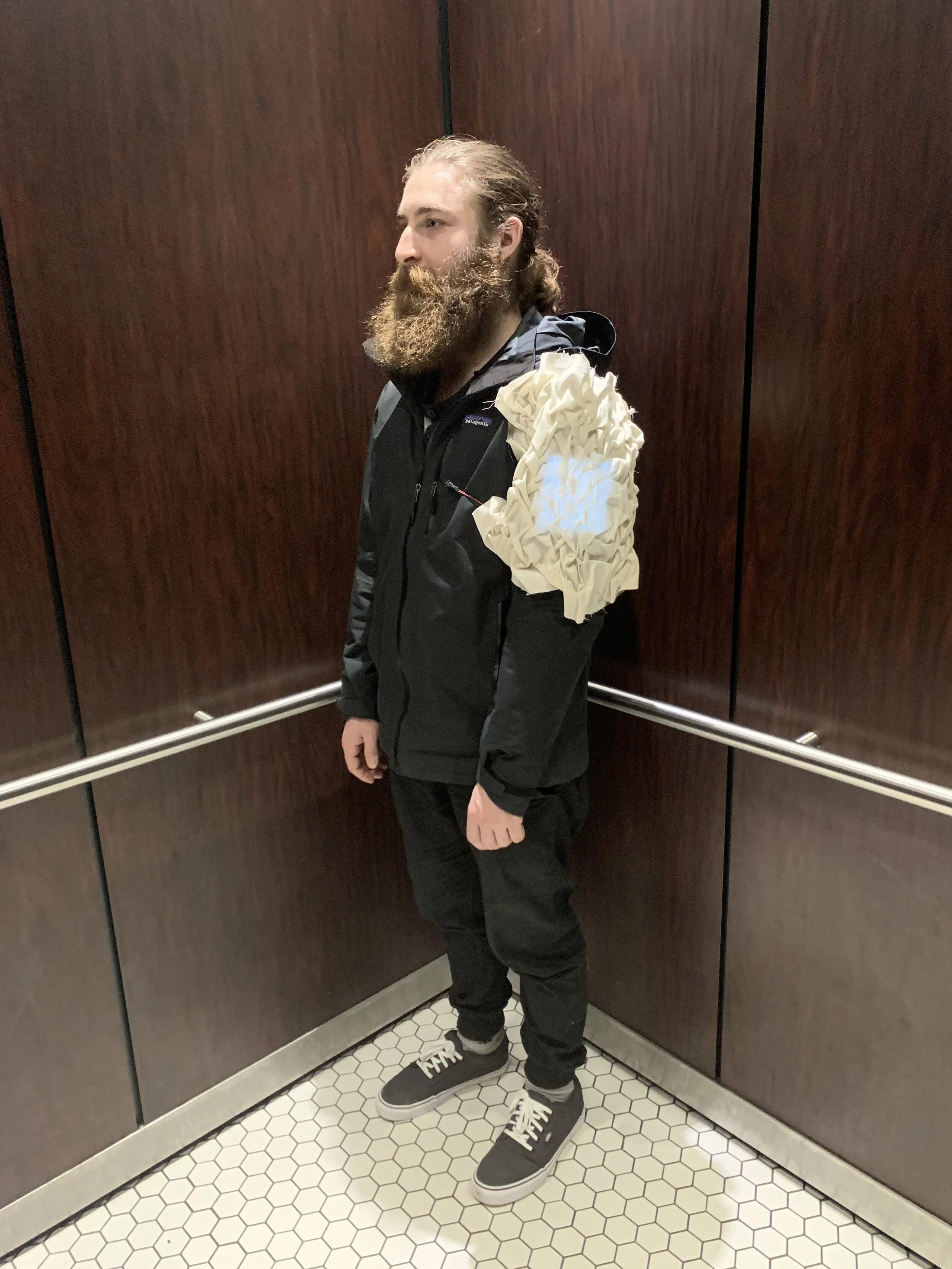Interfacing The Body and The Problem of Personal Space by Brian Kinnee
Motivating Questions:
What is personal space?
How did we come to our current understandings of it?
Where is there room to alter or improve how we think of, express, and regulate our personal spaces?
How can we think of personal space as a phenomenon that extends well beyond the individual body?
How can we move towards a more interpersonal, interrelational way of mapping the boundaries of personal space?
How can fabrics, textiles, and wearables play a key role in this process? What do practitioners and scholars alike need to know?
Personal space is a complex phenomenon that warrants further explorations for scholars and practitioners alike in design and engineering-related fields. I approach the problem of personal space through intersections between art and design. More specifically, I am being trained as both a Human-Centered Designer & Engineer and a Digital & Experimental Media Artist. This project, called “Interfacing the Body & The Problem of Personal Space” was one of my first attempts to weave these two conversations together. I wanted to start putting the overlapping histories, disciplines, practices, and theories in touch.
This project explores these intersections through several modes of inquiry. The first is taking seriously the necessity of practice to inform one’s artistic and design-based research. I ascribe to these traditions by exploring the process of smocking fabrics as a mode of data analysis.
KEY DEFINITIONS:
Personal Space: “the area individuals maintain around themselves into which others cannot intrude without arousing discomfort” (Joosse et al. 2014).
Prosthesis: AKA prosthetics, an extension of the body into space.
Embodiment: The degree in which someone experiences presence within a vessel. This vessel may be a screen, their own body, a vehicle, etc..
Methods & Materials Chosen:
Muslin fabric for rapid prototyping
Light in the form of an electroluminescent EL pad
Fabric Manipulation: “The art of creating constructed textiles” (Singer 2013)
Smocking: The form of fabric manipulation that I chose for this project. [Insert photos and written description of smocking/smocked fabrics from paper]
My Practice:
My practice is increasingly incorporating craft as a way of knowing. Much of my formal training has been in technical writing/editing, psychology, and science and technology studies (STS). Recently, I began exploring the realms of performance art, electronic textiles, physical computing, interaction design, and digital fabrication as well. I am increasingly motivated to create tangible artifacts in my practice—sometimes writing alone doesn’t feel like it’s enough. As a writer, this is sometimes a difficult but interesting tension; I am drawn towards developing my craft as a mode of more accessible communication.
Creating wearable prostheses that allow the wearer(s) to communicate complex, often invisible, information to people around them.
I am developing frameworks that incorporate speculative and critical design.
Creating wearable experiences, versus products that are “ready for market”.
Asking questions through fabrication; design as inquiry and research through design.
Draws on theoretical frameworks from cybernetics, proxemics, systems theory, and Science & Technology Studies (STS).
Focuses on making “human centered design & engineering” a more concrete process that is more readily visible.
Occupies the nexus between art and design--drawing on each to inform the other.
Paper in Progress: Abstract
HCDE researchers are increasingly drawing on theories and approaches from research through design and craft. Such efforts have focused on understanding diverse users, communities, and practices. This paper presents a pilot study, which involved cognitive mapping surveys, and a series of research prototypes in the form of smocked fabrics. Fabric manipulation was employed as a method for theorizing about the abstract concept of personal space, and for making deeper sense of pilot data obtained through the cognitive mapping surveys. The approach described within the paper is closely aligned with “thinking as handwork” [19]. The paper concludes with some directions for future research into the engineering of interactive wearable prostheses designed for the problem of personal space.
PROJECT OVERVIEW:
An exploration of personal space through fabric manipulation and using smocked fabrics as wearable prostheses.
A movement towards a more collectivized model/conception of personal space.
A quasi-experimental design inquiry geared toward greater understanding of personal space(s) beyond the unitary, isolated self in space.
A material practice that employs the frameworks of research through design, critical making, and design as inquiry.
Versus formal lab studies, this project deployed prototypes in-the-wild using the paratyping technique.
Provides a preemptive literature review on the guided research question: “What is a personal space?”
Employed fabric manipulation as data analysis.
Began developing cognitive mapping and data collection protocols—with the smocked fabrics acting as a social lubricant to build rapport.
Opted for a Wizard-of-Oz prototyping method in lieu of a calibrated distance sensor for mapping distances and arenas of personal space
KEY TAKEAWAYS
Began identifying key regions of the body that are tied to personal space.
Opened up dialogues surrounding how and when a sensory/sensing prosthesis is or is not more effective than traditional human sensing.
Recognized customizability as a virtue for wearable prosthesis design.
Teaching smocking to others as a way of gaining rapport to foster discussion about personal space ideas and practices.
Personal space is an issue that warrants greater attention from a disability studies perspective.
Began formulating personal space IoT landscape development.








